| Please access the following URL if you want to secure using SSL. All pages in the site will be secure pages. |
| https://secure02.blue.shared-server.net/www.fish-food.co.jp/message english 8.2020.html |
Welcome to FISH FOOD TIMES

Aug. 2020 issue No.200

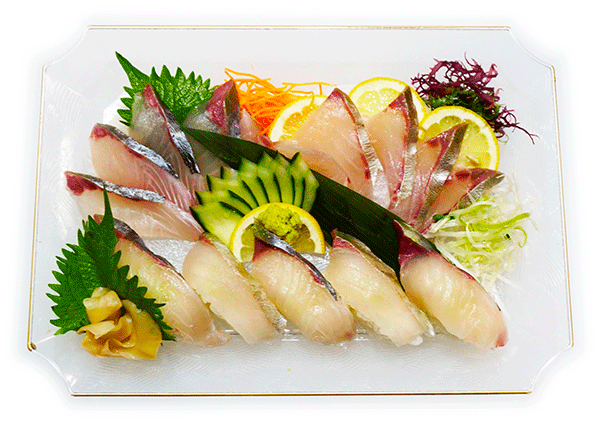
White trevally sashimi & sushi
Representative of high-class fish
White trevally is a high-grade fish that is said to be in season in the middle of summer. The white trevally classified as Carangformes Order, Carangidae Family, Pseudocaranx Genus is more expensive in terms of price than the greater amberjack classified as Seniola Genus of the same Carangidae Family.
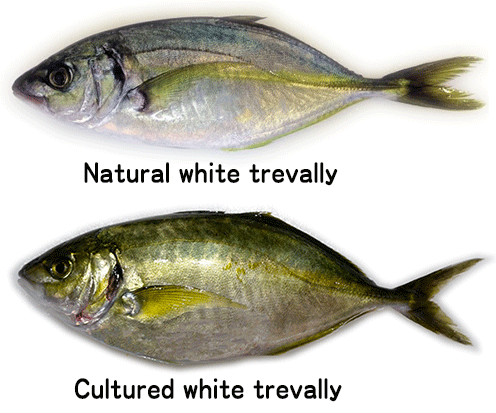
Natural products of white trevally are rare enough to be treated as phantom fish, and most of the things that are distributed should be regarded as aquaculture. The production of the cultured white trevally was only 3,300 tons nationwide in 2015, compared to the production of about 34,000 tons of aquaculture greater amberjack in the same year, the distribution volume is only about 1/10.
The monthly wholesale situation at the Toyosu Market is as follows.
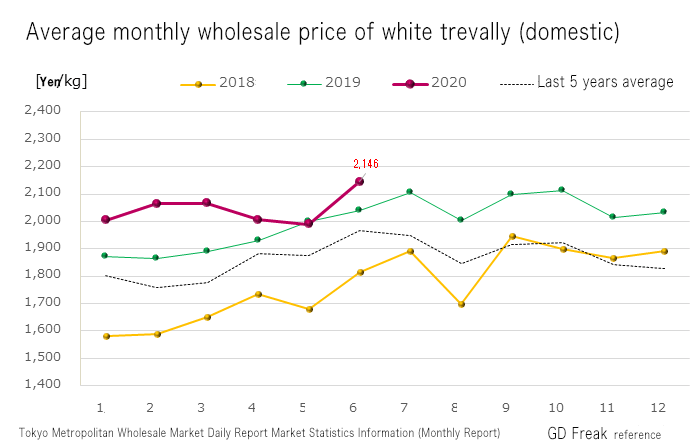

I expected wholesale prices to have fallen further since the April Declaration of Emergency, but the price cuts were not that great. On the contrary, it was a surprising fact that the price was higher than last year after June. This fact should be regarded as the fact that the wholesale price was maintained due to the extreme drop in the handling volume in April and May.
By the way, in the case of greater amberjack, this is let's look be's going on.
As you know, the greater amberjack started to soar around the beginning of last year and kept the high price of the plateau market until this spring. However, the market is in the process of weakening due to the influence of the new coronavirus.
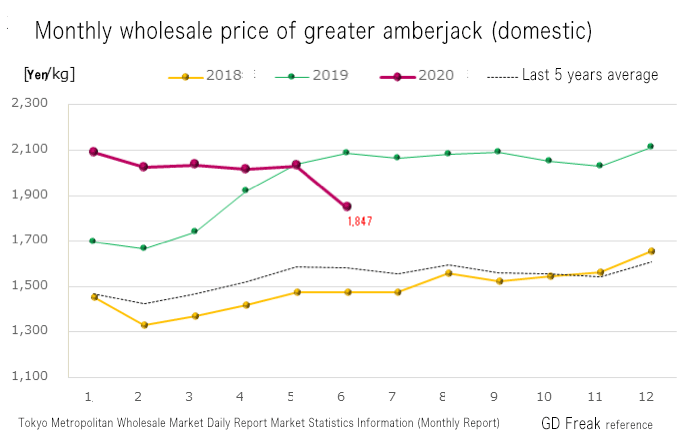
On average, the handling volume of greater amberjack was more than 5 times that of white trevally, but it seems that the quantity has dropped considerably due to the influence of the new coronavirus.
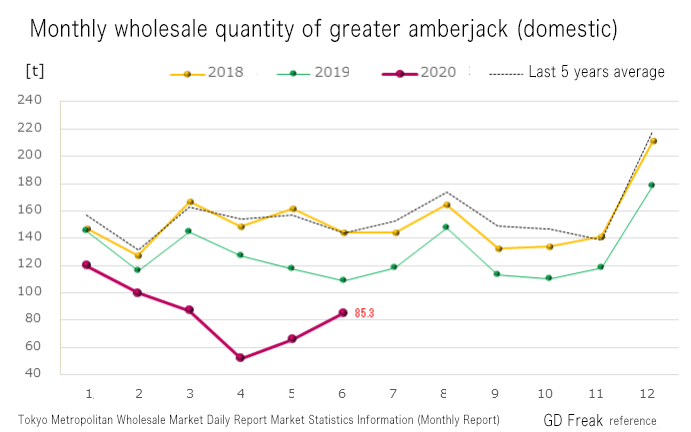
The silver color of the silver skin that makes you fall in love
The members of the Carangidae Family to which white trevally belongs are more than 50 kinds, even if they are only edible targets and lightly counted, and there are numerous kinds of relatives.
Even at FISH FOOD TIMES, the members of the Carangidae Family have dealt with various things in the past. There is "whitefin trevally" that was taken up in the December 2016 issue No.156 in the sense that its shape is very similar to white trevally. I won't make a new mention of whitefin trevally in this issue, but one of the very similar features is the subcutaneous fat layer, called the silver skin.
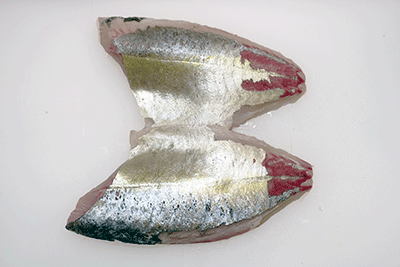
The upper image is the silver skin (subcutaneous fat layer) of white trevally, and the lower image is the whitefin trevally subcutaneous fat.

The silver skin of whitefin trevally is covered with almost silver and has a relatively simple appearance. However, in the case of white trevally, green, blue, yellow, etc. are spread moderately on the basis of silver, so it becomes a complex shade due to the addition of several colors, and its beauty is more than whitefin trevally.
The biggest attraction of white trevally is this silver skin. The silver skin improves the appearance when it is made into sashimi or sushi, and the deliciousness is also concentrated in the silver skin.
| Work to remove fish skin from white trevally |
 |
| 1, without dividing into back body and belly body, put the edge of yanagiba near the caudal fin on the skin with half body. At this time, it is better to leave scute without removing it, because it is easier to do because it does not cut the skin. |
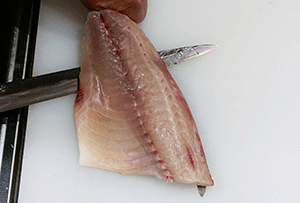 |
| 2,Using sotobiki's method, carefully move yanagiba back and forth so that the silver skin remains, and cut forward toward the head. |
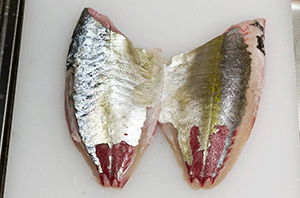 |
| 3Since there is scute in the part near the caudal fin, it is necessary to avoid the protrusion, and it is difficult to leave the silver skin. |
Commercialization utilizing silver skin
When making white trevally products, try to make the best use of silver skin, which is the greatest attraction.
| White trevally sashimi & sushi work process |
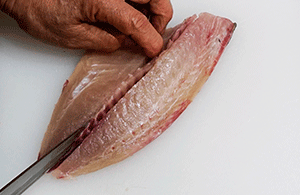 |
| 1,white trevallyをback bodyとbelly bodyに分ける。この時、belly bodyは鮨ダネに使うことを前提にするので、back bodyを刺身に好都合なsaku shapeにせず、chiai boneに沿って切り分けている。 |
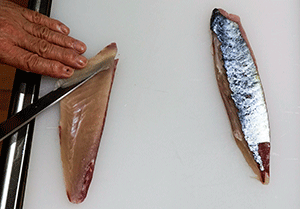 |
| 2,The belly body is made into a sushi material by the sogitukuri method with the left posture. |
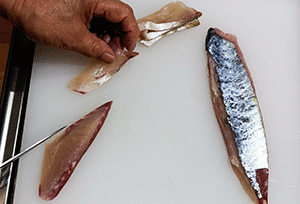 |
| 3,The silver skin stands out when koba is stood firmly with a yanagiba knife. |
 |
| 4,Make sashimi usutsukuri while checking the thickness of the silver on the back body. |
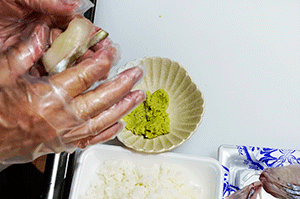 |
| 5,Make nigiri sushi with sushi material on the belly body. |
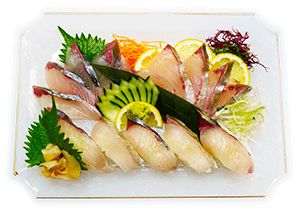 |
| white trevally sashimi & sushi (large) |
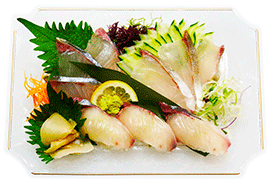 |
| white trevally sashimi & sushi (small) |
In addition to this, if you commercialize sashimi and sushi, you can also do the following.
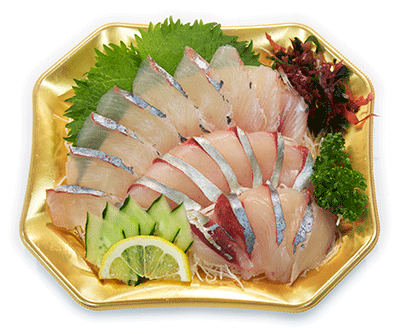
| Sashimi using half of white trevally |
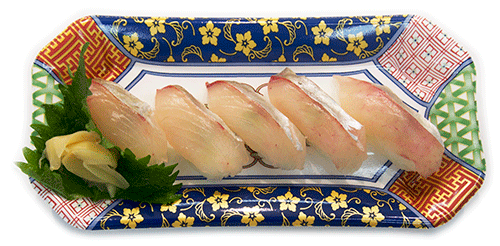
| Sushi using belly body of white trevally |
White trevally is a fish of the Carangidae Family, but not a reddish-colored body unique to blue fish, but a clear white body. It has a good balance of transparency and silver skin, and can be made into sashimi and sushi products with a very elegant atmosphere.
white trevally cuisine
After all, the expensive white trevally fish is basically sashimi and sushi. Of course, if you know that it is a high-cost raw material, you can also cut this into a Western-style dish such as Meunier.
| Meuniere cooking process of white trevally | |
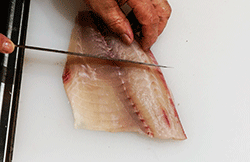 |
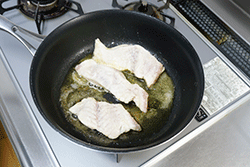 |
| 1Cut the half body with the skin down by pushing it, raise the knife at one skin and pull the knife to separate it. | 5,Bake the skin first with butter. |
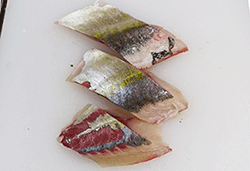 |
 |
| 2,Cut the tail wide so that it is as even as possible. | 6,Covered with a lid, bake it in the smother |
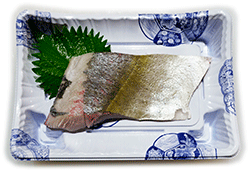 |
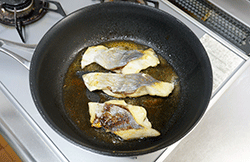 |
| 3,When selling white trevally, the cost is high, so one piece is the standard. | 7,When the skin is grilled to the extent that it becomes brown, turn it over and grill the fish meat. |
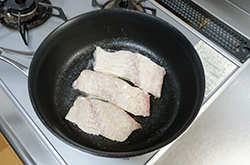 |
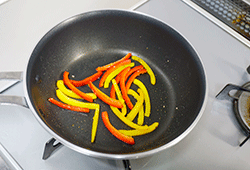 |
| 4,Put the fillet with flour on the surface in a frying pan. | 8,Cut paprika into thin pieces and fry lightly. |
 |
|
| Meuniere of white trevally | |
When it comes to making a white trevally muniel, the cost of a piece of fillet is quite expensive, so there is a difficulty that is not as great as when using frozen fish whose selling price is also low. However, if you use the white trevally leftover fish scraps, the cost can be considered to be zero, so I decided to make a Ushio-jiru soup using leftover fish scraps with good broth.
| Ushio-jiru soup cooking process of white trevally |
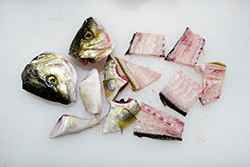 |
| 1,Cut white trevally left over fish scraps into appropriate size. Keep the original shape without making the head too small. |
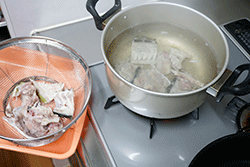 |
2,Lightly hot water frost all over the leftover fish scraps and put in boiling water. |
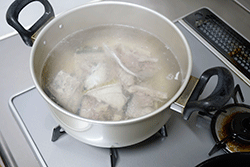 |
| 3,Cook for a while until the heat goes through. |
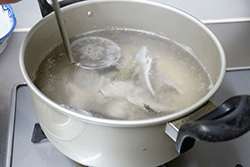 |
| 4,While boiling, Skim the foam from the top of the soup. |
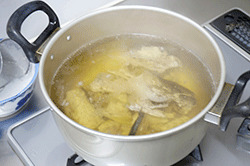 |
| 5,Finally, season with salt and soy sauce. |
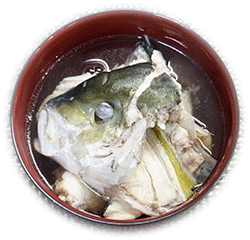 |
| Finish with the head on top so that it stands out and put in a large soup bowl. |
An elegant and noble fish, white trevally
What kind of fish is white trevally? When I describe it myself, it becomes as follows. I think that it can be said that it is "graceful and discreet and elegant" among fish intended to be eaten, not ornamental fish. Also, the fish body is not too large, the physical condition is transparent, the silver skin is beautiful and brilliant, the fat is not too thick, it is not so light, it does not stick out. And the white trevally is a fish that is in an expensive position that you can't easily get and feels a little noble away from the masses.
When commercializing, it is white trevally that requires a posture that can not be handled roughly. And it is the white trevally that will respond in an orderly manner when facing such a posture. As a person whose primary business is to handle fish and sell them as products, it may be said that they will naturally have with respect, and such fish are rarely seen.
It has often been mentioned that the silver skin that appears when the skin is removed during cooking is the most characteristic feature of white trevally. The skin that covers the surface is very weak, and there is a weakness that immediately erodes even a little, and such "weakness that can be said to be fleeting" also expresses the nobility of white trevally.
There are very few natural white trevally fish that are often found in restaurants and high-class Japanese restaurants, so when fresh natural trevally arrives, the price tends to go up without knowing the ceiling. As a matter of fact, the fact that Japanese restaurants are basically dependent on aquaculture white trevally is also a reality.
In 1987, the Kagoshima Prefectural Cultivation and Fisheries Center artificially hatched white trevally, and succeeded in hatching 3,219 larvae of 100 mm long. Furthermore, in 1988, a mass production basic test was conducted in a large water tank, and the success of hatching 56,600 fish with a size of 70 mm in length started the history of aquaculture white trevally. Without the success of this artificially hatched larvae, white trevally would have been too rare to get into the distribution and would not have the same presence as it does now.
Although aquaculture greater amberjacks have become an indispensable existence at fish retailing sites, aquaculture white trevally is not in the same position in terms of price. White trevally seems to be seen in Ryotei and high-class Japanese restaurants in the same way as the greater amberjack in fish retail. And in the future, the cultivation of white trevally will continue to experience high plateau prices due to the high price of artificial seedlings.
The white trevally, which has a noble presence, should not be aimed at the popular road, but should continue to be in its current position.
| Please access the following URL if you want to secure using SSL. All pages in the site will be secure pages. |
| https://secure02.blue.shared-server.net/www.fish-food.co.jp/message english 8.2020.html |
An opinion and the communication are to iinfo@fish food times
Date of updating 1 Aug. 2020
